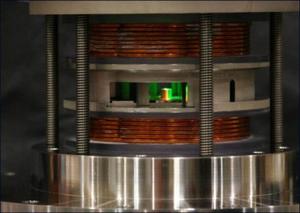Nuclear powerDry-run experiments confirm key aspect of Sandia nuclear fusion concept
Magnetically imploded tubes called liners, intended to help produce controlled nuclear fusion at scientific “break-even” energies or better within the next few years, have functioned successfully in preliminary tests, according to researchers

Sandia Lab's prototype MagLIF fusion reactor // Source: energy.gov
Magnetically imploded tubes called liners, intended to help produce controlled nuclear fusion at scientific “break-even” energies or better within the next few years, have functioned successfully in preliminary tests, according to a Sandia research paper accepted for publication by Physical Review Letters (PRL).
To exceed scientific break-even is the most hotly sought-after goal of fusion research, in which the energy released by a fusion reaction is greater than the energy put into it — an achievement which would have extraordinary energy and defense implications.
A Sandia release reports that the fact that the liners survived their electromagnetic drubbing is a key step in stimulating further Sandia testing of a concept called MagLIF (Magnetized Liner Inertial Fusion), which will use magnetic fields and laser pre-heating in the quest for energetic fusion.
In the dry-run experiments just completed, cylindrical beryllium liners remained reasonably intact as they were imploded by huge magnetic field of Sandia’s Z machine, the world’s most powerful pulsed-power accelerator. Had they overly distorted, they would have proved themselves incapable of shoveling together nuclear fuel — deuterium and possibly tritium — to the point of fusing them.
Sandia researchers expect to add deuterium fuel in experiments scheduled for 2013.
“The experimental results — the degree to which the imploding liner maintained its cylindrical integrity throughout its implosion — were consistent with results from earlier Sandia computer simulations,” said lead researcher Ryan McBride.“These predicted MagLIF will exceed scientific break-even.”
A simulation published in a 2010 Physics of Plasmas article by Sandia researcher Steve Slutz showed that a tube enclosing preheated deuterium and tritium, crushed by the large magnetic fields of the 25-million-ampere Z machine, would yield slightly more energy than is inserted into it.
A later simulation, published last January in PRL by Slutz and Sandia researcher Roger Vesey, showed that a more powerful accelerator generating 60 million amperes or more could reach “high-gain” fusion conditions, where the fusion energy released greatly exceeds (by more than 1,000 times) the energy supplied to the fuel.
The release notes that these goals — both the near-term goal of scientific break-even on today’s Z machine and the long-term goal of high-gain fusion on a future, more powerful machine — require the metallic liners to maintain sufficient cylindrical integrity while they implode.
The liner is intended to contain fusion fuel like a can holds peanut butter, and push it together in nanoseconds like two semicylindrical shovels compacting snow together.
An element of drama is
